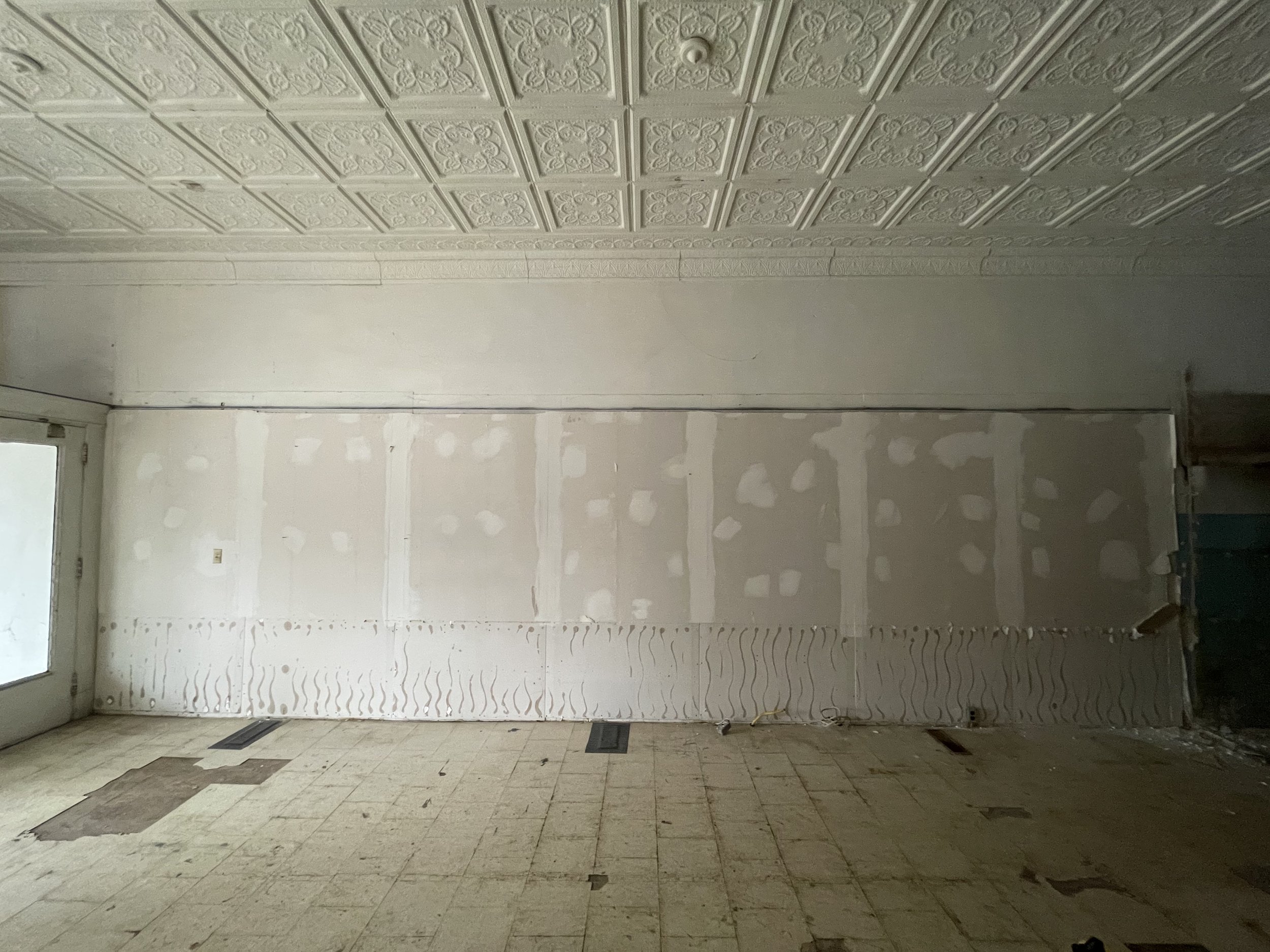E. (Edward) F. Cummings
The Adams Express Company under the direction of E. F. Cummings was the first tenant of the “Brick Block” in 1891 at 523 Market Street; the northern most storefront on the block. Mr. Cummings, an early pioneer of Johnsonburg, led a very curious but fruitful life that began under less than normal circumstances and ended about the same way.
Edward F. Cummings (Cominos), (Cummins), was born in New Bethlehem, Pennsylvania on January 17, 1858 to S. A. and Mary A. Space Cummings. Whatever happened to S.A. Cummings is unknown but sometime around 1863 Mary Space Cummings married John O’Donnell of New Bethlehem. In the 1870 Federal Census Edward Cummings is 10 years old and living with his mother Mary, stepfather John O’Donnell, and step-brothers George, Arthur, and step-sister Addie.
According to his own biography noted in the “History of McKean, Elk, Cameron, Potter and County-1890” E. F. Cummings is educated in New Bethlehem, begins clerking in a local store at age 12, and signs on as a clerk for the Alleghany Valley Railroad in 1876. Indeed, in the 1880 Federal Census Edward is employed as a clerk in New Bethlehem but his living circumstances have changed somewhat; his mother is gone (likely deceased) and he has a step-mother, Kate, along with a new step-brother, Frank. His younger step-brothers and step-sisters remain with the family as does his step-father, John O’Donnell. Two other step-sisters, Marie and Teresa, will join the family after 1890. E. F.’s step-siblings and their offspring will remain close to E. F. and one another throughout their lives.
In 1881 the Bradford, Eldred, and Cuba Railroad hires E.F. to supervise their Ceres, Pennsylvania station. This is an extensive narrow gauge New York and Pennsylvania state railroad line serving freight and passenger traffic throughout the oil field area. Its 54 miles of track would operate from 1881 to 1893 when it was sold in bankruptcy.
In 1886 the ambitious twenty-eight-year old E. F. Cummings, recently married (December 17, 1884) to Mary Eleida More of Emporium, takes the position of manager of the Philadelphia and Erie Station in Johnsonburg, Pennsylvania. In 1891 he will retire from the railroad and begin working for the Adams Express Company, the largest freight hauling company on the east coast at the time.
Around 1889 the well-respected E.F. Cummings becomes the Justice of the Peace in Johnsonburg, serving in that capacity throughout the 1890’s. He will continue to represent the Adams Express Company and move his operations from the Brick Block to the Barry Opera House (future Johnsonburg theater) and opens a Travelers of Hartford Life Insurance and Accident Company at that location while also dabbling in real estate.
Mr. Cummings is involved in many Johnsonburg community affairs including politics as a leader of the Jeffersonian Party in Elk County. He is also a staunch member of the Catholic Church and is influential in the building of the Catholic Church on the corner of Market and Spruce Streets in Johnsonburg. He and Mary’s son Levi Thompson Cummings was born in Johnsonburg on May 13, 1890. They would also have a daughter Eleanor whose birth date is unknown but who died sometime before 1900.
In early 1900 E. F. Cummings sells his Real Estate, Insurance, and Adams Express business to a partnership established by Adams Express employees Frank O’Donnell and George Clement Smith. Frank O’Donnell was E. F. Cummings’ step-brother. The O’Donnell-Smith Insurance Agency partnership does not survive the decade as Mr. Smith buys out Mr. O’Donnell. Mr. O’Donnell becomes a prominent banker at the Johnsonburg National Bank until his death in 1928. E. F. Cummings moves his family from Johnsonburg to Bellevue, Pennsylvania, near Pittsburgh and establishes a new real estate and insurance agency. Around 1910 the family moves to Braddock, Pennsylvania and Mr. Cummings works as an agent for fire extinguishers.
E. F. Cummings died in Pittsburgh on February 10, 1930, his funeral was held in Johnsonburg. His wife, Mary, passed in 1937 in Pittsburgh, her funeral was held in Johnsonburg also.
E. F. Cummings, his wife Mary Eleida, and their daughter Eleanor are interred in the Laurel Hill Cemetery in Johnsonburg although there are no current headstones noting the whereabouts of their final resting places. Their son Levi, an accountant by trade, died of alcoholism in Pittsburgh in 1944. He is buried in Pittsburgh.
E. F. Cummings arrived in Johnsonburg while the paper mill was still a dream in Meylert and Lewis Armstrong’s fertile minds. During his 15 years in Johnsonburg, Cummings witnessed the building of the massive Armstrong Paper Mill, the Johnsonburg Bank, the Brick Block, the Armstrong Hotel, the Johnsonburg Hotel, W. E. Zierden’s Store. and the Barry Opera House, along with hundreds of houses, many boarding houses, and a few more hotels. He prospered as Johnsonburg grew from a small hamlet to a large industrial railroad community. Why he left Johnsonburg for the Pittsburgh area in 1900 is lost in the unwritten pages of history but it was likely to better himself and his family as that seemed to be his habit throughout his interesting career.
NOTES:
George C. Smith, the Smith half of O’Donnell and Smith Insurance Agency, sold a partnership in the business to John B. Keats shortly before Mr. Smith died on July 7, 1946. So began the Smith-Keats Insurance Agency of Johnsonburg.
The Adams Express Company had its own railroad cars and delivered documents, money, parcels, and freight all along the East coast of the United States. At one time it also delivered letters but in 1845 the U.S. Government passed laws that protected the U. S. Post Office which effectively prohibited the Adams Express Company from delivering mail, a large part of their business at the time. However, during the Civil War the company profited greatly by shipping goods, supplies, and payrolls to the armies of the Union and the Confederacy. In 1918 the U.S. Government federalized the nation’s railroads to more effectively move the nation’s troops and supplies. Adams, Wells Fargo, and American Express were sold for stock options to the United States controlled American Railway Express Company (AREC). AREC eventually became the privatized Railway & Express System (1929) with Adams Express Company owning 75 percent of the company as they had bought out American Expresses shares. At that time Adams had no physical transportation equipment to speak of; they were in essence now an investment company. Adams Funds exists today as a long-term investment company, American Express is a leader in the credit card business, and Wells Fargo is a banking conglomerate. All three were originally express companies.
E.F. Cummings’ grandson, Thompson Cummings, a West Point graduate in 1952, died in Korea in December 1953; he was a well-decorated soldier. His granddaughter, Patricia, became a nun.
The Cummings-O’Donnell family were a tight-knit group. There are many notices in the newspapers of the day of the family visiting one another in Dubois, Johnsonburg, Kane, Erie, Pittsburgh, Smethport, and Buffalo.
Kevin “Reg” Barwin January 2023
Kevin Barwin, a Johnsonburg native, who spent his youth peddling newspapers in Johnsonburg and reading the newsprint, while walking his routes, acquired a taste for the past.
THE PAPER BOY FROM THE PAPER CITY, More on his book: here









